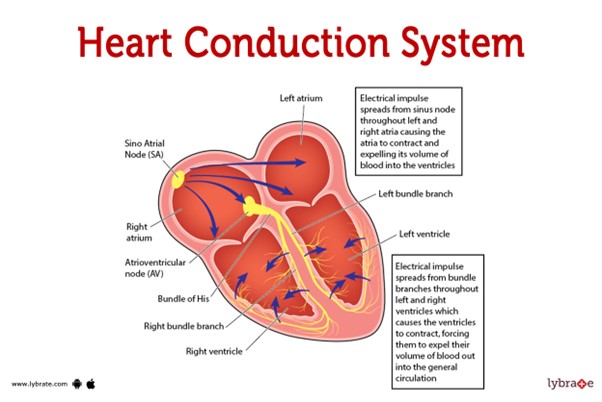The normal pathway of the conduction system is which one of the following?
SA node - AV node - bundle of his - bundle branches - Purkinje fibers.
SA node - bundle of his -AV node - bundle branches - Purkinje fibers.
SA node - AV node - bundle branches - Ventricles - Purkinje fibers.
AV node-SA node - a bundle of his - bundle branches - Purkinje fibers.
The Correct Answer is A
 This pathway represents the normal sequence of electrical impulses that coordinate the contraction and relaxation of the heart chambers.
This pathway represents the normal sequence of electrical impulses that coordinate the contraction and relaxation of the heart chambers.
The electrical signal originates from the sinoatrial (SA) node, which is often referred to as the natural pacemaker of the heart. It is located in the right atrium and generates the electrical impulses that initiate each heartbeat. From the SA node, the electrical signal travels to the atrioventricular (AV) node, which is located at the junction between the atria and ventricles.
After passing through the AV node, the electrical impulse travels through the bundle of His (also known as the atrioventricular bundle) and divides into the right and left bundle branches. These branches continue the conduction pathway and deliver the electrical signal to the Purkinje fibers.
The Purkinje fibers spread the electrical impulse rapidly throughout the ventricles, stimulating the contraction of the ventricular muscle and allowing for efficient pumping of blood out of the heart.
Therefore, the correct sequence of the normal conduction pathway in the heart is:
A. SA node - AV node - bundle of His - bundle branches - Purkinje fibers.
Nursing Test Bank
Naxlex Comprehensive Predictor Exams
Related Questions
Correct Answer is B
Explanation
Shock is a state of inadequate tissue perfusion, resulting in compromised oxygen and nutrient delivery to cells and impaired cellular metabolism. Regardless of the specific cause or type of shock (e.g., hypovolemic, cardiogenic, distributive), the underlying problem is the failure to supply sufficient oxygen and nutrients to the body's tissues. This inadequate tissue perfusion can lead to cellular dysfunction, organ failure, and ultimately, life-threatening consequences.
A. Inefficient metabolism resulting from inadequate nutrition in (option A) is incorrect because While inadequate nutrition can contribute to the overall health status and resilience of an individual, it is not the central mechanism underlying all shock states.
C. Vasoconstriction and reflexive vasodilation due to circulating mediators in (option C) is incorrect because Vasoconstriction and vasodilation are physiological responses that can occur in various types of shock, but they are not the fundamental common denominator. Inadequate tissue perfusion remains the core issue.
D. Hypovolemia resulting from blood loss in (option D) is incorrect because Hypovolemia, which refers to decreased blood volume, is one potential cause of shock, specifically hypovolemic shock. However, other types of shock, such as cardiogenic or distributive shock, may not be primarily characterized by hypovolemia.
Therefore, the common denominator of all shock states is inadequate tissue perfusion, resulting in impaired cellular metabolism.
Correct Answer is D
Explanation
Norepinephrine is a vasopressor medication commonly used in the management of septic shock. It acts as a potent vasoconstrictor to increase systemic vascular resistance and improve blood pressure. By constricting blood vessels, norepinephrine helps restore tissue perfusion and improve organ function.
A. Nitroglycerine (Tridil) in (option A) is incorrect because: Nitroglycerine is a vasodilator and would further lower blood pressure. It is not suitable for a patient with septic shock who already has low blood pressure.
B. Atenolol (Tenormin) in (option B) is incorrect because: Atenolol is a beta-blocker and would further decrease heart rate and blood pressure. It is not appropriate for a patient in septic shock who requires intervention to increase blood pressure.
C. Dobutamine (Dobutrex) in (option C) is incorrect because: Dobutamine is an inotropic medication used to increase cardiac output. While it can be helpful in certain types of shock, such as cardiogenic shock, it is not the first-line choice for septic shock when there is inadequate blood pressure response.
Whether you are a student looking to ace your exams or a practicing nurse seeking to enhance your expertise , our nursing education contents will empower you with the confidence and competence to make a difference in the lives of patients and become a respected leader in the healthcare field.
Visit Naxlex, invest in your future and unlock endless possibilities with our unparalleled nursing education contents today
Report Wrong Answer on the Current Question
Do you disagree with the answer? If yes, what is your expected answer? Explain.
Kindly be descriptive with the issue you are facing.
